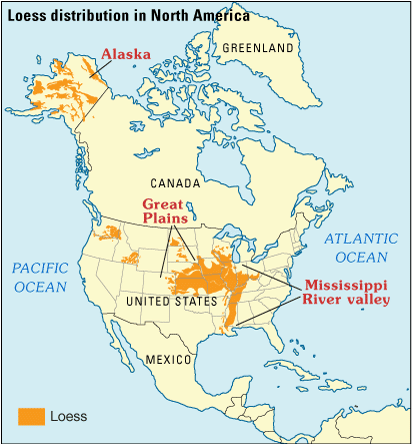 Roadcut through loess near Natchez, Mississippi
Roadcut through loess near Natchez, MississippiThe short answer is that loess is windblown glacial silt
The mineral particles it's composed of are very small. They're "silt" size, which means 0.002 to 0.05mm in diameter -- much smaller than sand and gravel particles. Most soils contain a mixture of sand, silt and clay in different proportions, but loess particles are just silt size.
 Image courtesy of US Geological Survey
Image courtesy of US Geological SurveyOne feature making loess deposits easy to spot, besides its typical buff to yellowish-brown color, is that it erodes with a "high angle of repose," meaning that it forms vertical or near-vertical faces like that shown in the above picture.
Besides the North American distribution of loess shown in the map a the left, large loess deposits are found here and there worldwide. China has especially vast deposits.
Loess is tricky for agriculture and gardening. When pure loess gets wet, it's like gravy and easily washes away. When wet loess dries out, it's hard. Air and water can't circulate easily in loess, which is a problem for things living in loess. However, loess is chemically nutrient rich, and when loess soil contains plenty of organic matter and is mixed with sand or other-sized particles, it can be very productive.
For most of us, however, loess itself is much less interesting than the stories behind it, and the things and people, living and nonliving, associated with it.